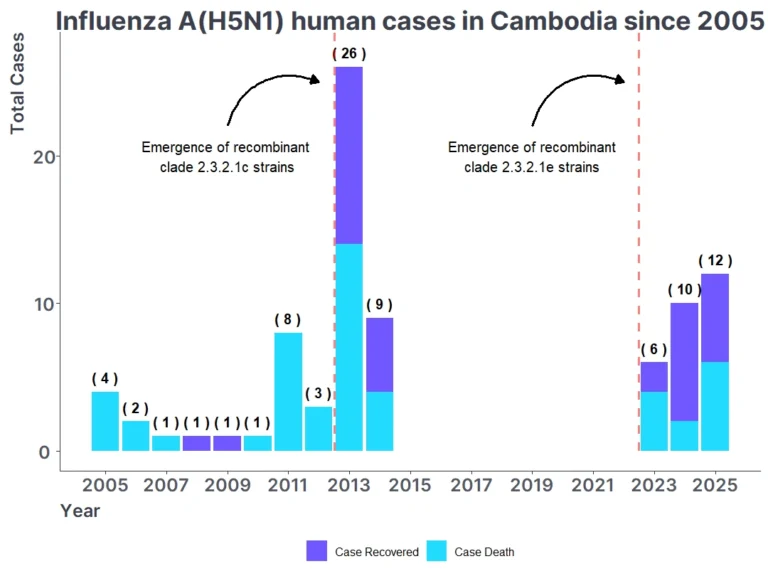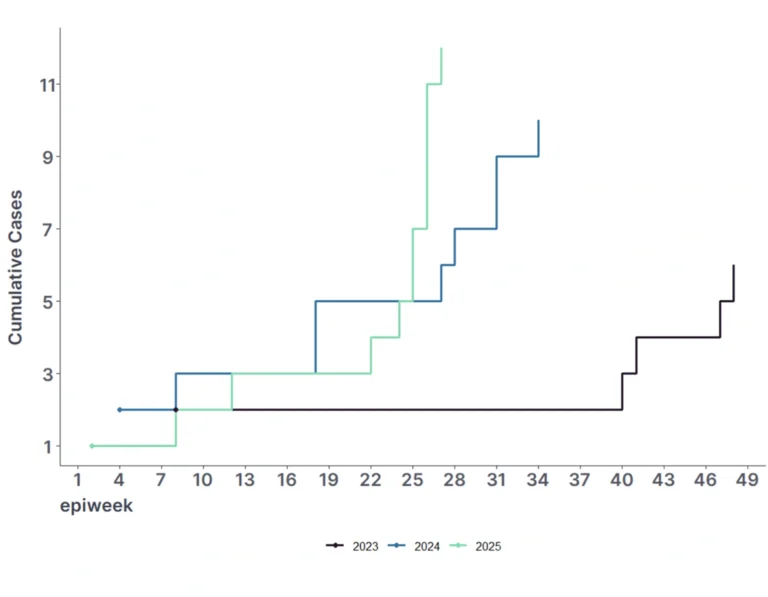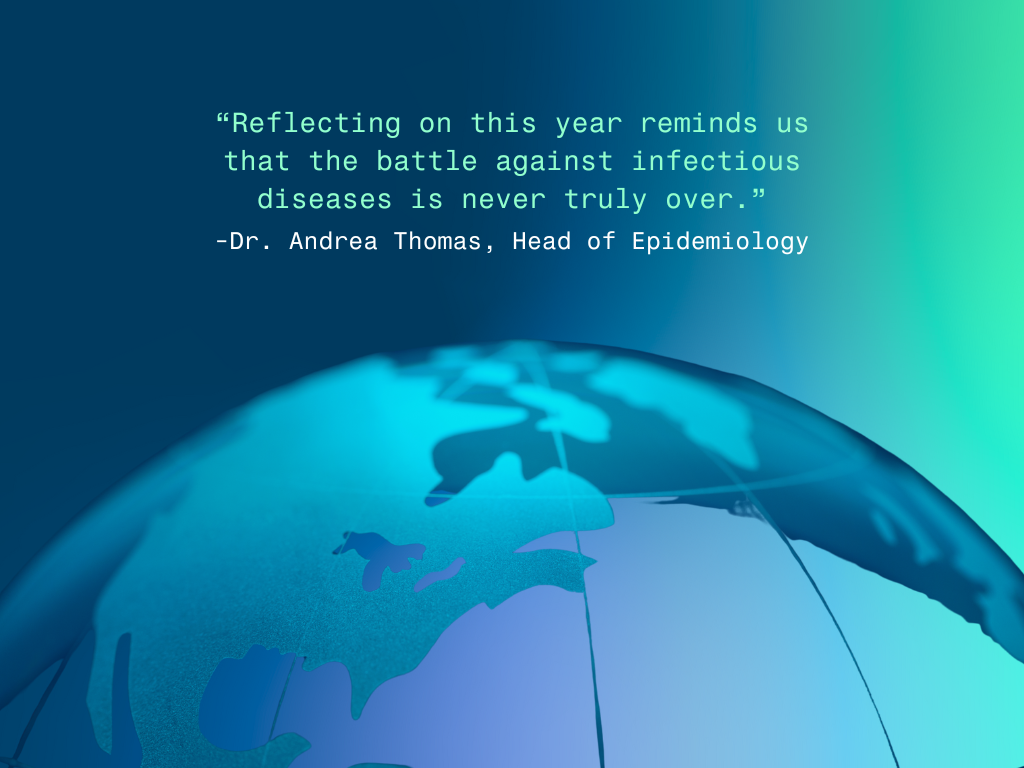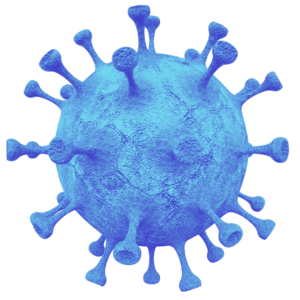Human cases of H5N1 reemerged in the region following a 2023 viral reassortment. Cases have now reached their highest peak in 12 years.
Last month, an unusual surge in human cases of influenza A(H5N1) arose in Cambodia, leaving 7 people infected and 2 dead. The country’s total number of cases for this year is now 12 and the death toll stands at 6, marking a decade-high spike of the troubling respiratory infection.
Eight of the country’s 25 provinces have reported cases so far. Importantly, all cases have been linked to exposure to sick or dead poultry, primarily from those raised for by households for their consumption kept in backyards. These cases trace back to the virus’s reemergence in humans back in February 2023, when a viral reassortment — a process where separate strains of the H5N1 virus mix genetic material and produce a new viral combination — occurred. Since then, the small Southeast Asian country has seen year-over-year increases in case counts.
“Ongoing spillover into humans is a massive risk,” says Andrea Thomas, PhD, BlueDot’s head of epidemiology. “The increased amount of spillover infections in humans raises the risk of reassortment or of a pandemic, even if we can’t predict how likely a pandemic is to occur.” Highly pathogenic avian influenza (HPAI) A(H5N1) is known to circulate within poultry in the country, but neighboring and nearby countries have not reported similar trends, as might be expected, given that wild birds and poultry can move the virus across borders (the former by flight, the latter by trade).
Fortunately, no human-to-human transmission has been reported, but the recent surge includes many unknowns, including whether this new strain can more easily infect humans or make people sicker. This edition of Outbreak Insider takes a closer look at the situation in Cambodia: what we know, what we don’t, and whether these cases could be a sign of something more concerning.
Cases of influenza A(H5N1) take off in Cambodia
The first human cases of influenza A(H5N1) were discovered in 1997, less than 30 years ago, following a large poultry outbreak in Hong Kong. Sporadic human cases have been reported since then. Symptoms among those infected can range from asymptomatic or mild upper respiratory tract symptoms to severe, life-threatening conditions, such as brain swelling and brain damage. Although human cases of influenza A(H5N1) infection are uncommon, they are geographically widespread. Birds, the virus’ primary host, have flown the virus far and wide, infecting humans in 23 countries on nearly every continent.
Since the virus was first detected in wild birds in Cambodia in December 2003, 84 human cases and 49 deaths have been reported. The largest spike in cases and deaths was reported in 2013 after the emergence of reassorted clade 2.3.2.1c.
From 2014 to 2022, Cambodia then experienced an eight-year stretch without any human cases. But by 2023, the virus had again reassorted in Asia and reemerged. This time the reassortant included gene segments from clade 2.3.4.4b, which has since circulated globally and caused the well-known outbreak in dairy cows in the United States. A total of 29 human cases and 12 deaths have been reported since then in Cambodia, representing a 43% case fatality rate.
Human Influenza A (H5N1) Cases in Cambodia, 2005 to July 7, 2025

Source: Data sourced from the World Health Organization, July 7, 2025.
Cases this year are widespread across the country. Eight provinces, including Siem Reap in the north, Kratie and Kampong Cham in the central region, and Kampot, Takeo, Svay Rieng, Prey Veng, and Kampong Speu in the south, have reported human cases. This is an increase from the six provinces that reported cases in 2024.
And since the disease’s reemergence, yearly case counts have crept up steadily. In 2023, six cases and four deaths were reported, while 2024 saw ten cases and two deaths. Up until July 7, 2025, compared to the same time frame last year, 2025 has seen a two-fold increase in cases in Cambodia. Unlike general trends seen in other countries, cases in Cambodia appear to be spiking in the early summer months, which don’t line up with typical bird migration patterns when risk of spillover infections in poultry and humans are more likely.
Cumulative Confirmed Avian Influenza A(H5N1) Cases by Year, 2023-2025

Source: BlueDot, July 7, 2025.
Curiously, nearby countries such as Thailand, Laos, and Vietnam are not reporting similar trends to Cambodia’s human influenza A(H5N1) cases. In fact, Vietnam is the only nearby country to experience cases. One which was reported by China in a Vietnamese traveler earlier this year and one another was reported by Vietnam in a child hospitalized for encephalitis. As of now, the human threat of influenza A(H5) does not appear to be impacting the region evenly based on the available data.
What’s driving an increase in cases?
Increased human cases across Cambodia since 2023 are linked to a novel reassortant: clade 2.3.2.1e, which is a combination of clade 2.3.2.1c and clade 2.3.4.4b — the latter clade being the one currently circulating globally. In Cambodia, this new clade has since replaced the endemic 2.3.2.1c clade that had afflicted the nation’s poultry for a decade. Reassortment events can result in a change to a virus’s properties including the transmissibility and infectivity in humans. Analysis of this new strain’s mutations suggests the virus may be better at infecting mammals — including humans.
Poultry is a mainstay of Cambodian cuisine, and backyard poultry farming is common. More than 50% of households raise poultry as an important source of nutrition and income. But with approximately 2.5 million (15%) people experiencing undernourishment, sick or dead poultry threatens livelihoods and food security. For pragmatic reasons, many continue handling or consuming sick infected poultry, posing a risk for further spillover.
Despite surveillance measures and widespread communications, community public health measures do not appear to be moving the needle in effecting safer practices. A 2023 study of rural villagers in Cambodia found that only one-third reported receiving information about avian influenza from healthcare providers. Instead, people tend to listen to trusted village leaders or neighbors, who may inadvertently reinforce risky behaviors, such as freezing meat in the mistaken belief that it will make it safe for consumption.
The same study identified that nearly 25% reported cooking sick or dead poultry to eat, and almost 10% touched infected poultry with bare hands. What’s more, only 50% of people heard advice not to touch or eat infected poultry when preparing food, and just over a third said they would follow that advice. Community norms and social pressure are implicated in the consumption of infected poultry as throwing food out or declining food can be seen as wasteful, prideful, or rejecting generosity. Like many countries, Cambodia does not have clear policies or programs to compensate people for culling sick poultry, especially for smaller home flocks.
These are just some of the various challenges that the government of Cambodia is facing, atop the many clinical challenges posed by this virus, as it works to improve understanding and change attitudes and behaviours toward avian influenza. It remains to be determined whether the new clade is more severe or transmissible, or if there are other factors at play that are resulting in the recent increase in human influenza A(H5N1) in Cambodia. But it’s clear that a strengthened, culturally sensitive strategy is needed to mitigate viral transmission within Cambodia and beyond.
3 Top Takeaways
- Influenza A(H5N1) cases in Cambodia this year have already surpassed last year’s total. Between January and July 7, 12 human cases and six deaths have been reported across Cambodia. Up from the 10 cases and two deaths reported last year, this year’s counts represent the highest number of human cases since 2013.
- A reassortment event appears to be driving year-over-year increases. After eight years of no human cases in Cambodia, a novel clade emerged in 2023 and led to a resurgence of H5N1. Since its reemergence, a total of 28 cases and 12 deaths have been reported. Experts are watching closely as the virus continues changing, raising more questions about the chances of an impending pandemic.
- A One Health approach is needed to curb the spike amid challenging public health context. Cambodia has strong surveillance and reporting for influenza A(H5N1). But ineffective communication, poverty and food insecurity, and cultural practices affect the success of public health efforts. Preventing additional infections and deaths in the nation — and globally — necessitates a transdisciplinary strategy.
Abating influenza A(H5N1) calls for a One Health approach
Ongoing viral diversification highlights the importance of continued monitoring and disease control measures to reduce opportunities for the virus to change in a way that could enhance its pandemic threat. It is especially important to understand the country-specific context to effectively manage outbreaks.
“These are messy, complex situations — what we call ‘wicked problems,’” says Thomas. “We need many people with diverse perspectives including within communities to help solve the problem collaboratively.” To this end, a One Health approach, which integrates a transdisciplinary, multisectoral strategy to improve the health of people and animals, has been implemented in Cambodia to guide public health efforts against infectious diseases.
The government’s response is improving despite the nation’s limited resources. Health and government workers are traveling to rural areas on motorbikes to spread disease awareness within communities. Influenza centres are conducting free lab testing every day. New tactics to tackle influenza A(H5N1) are also underway. For example, scientists have begun analyzing the air using a portable air sampler to filter and trap biological particles which they then extract to test for pathogens. Compared to swabbing animals, this innovative method to track disease is quicker, cheaper, and safer.
There are many unknowns about what’s happening with H5N1 in Cambodia, including the severity and transmissibility of the current strain, or whether the virus is also spilling over to other species. Time will tell how these national trends develop. But the unpredictability of influenza A(H5N1) means the threat of human infection in one country is a global health threat — one that experts will be watching closely.
On our radar
- Crimean-Congo Hemorrhagic Fever (CCHF) in Greece: In Thessaly, Greece, a fatal case of CCHF resulting from a tick bite was reported on June 26. The tick-borne viral hemorrhagic fever has a 30-50% mortality rate, and there are no vaccines or treatments available. Marking the country’s first locally acquired case since 2008, a multi-sectoral response has been initiated.
- Measles in the Americas: The measles outbreak across the Americas is continuing unabated. Last weekend, the US hit 1,281 cases, surpassing the highest number of cases since the year 2000 when it was declared eliminated. Nearby, Mexico’s outbreak is intensifying, with 3,075 cases and nine deaths — mostly in Chihuahua. In South America, Bolivia has declared a national public health emergency following confirmation of more than 60 cases. All countries have immunization rates below the recommended 95% threshold, underscoring the importance of vaccination in preventing outbreaks.
- Chikungunya in Réunion: In some good news, the chikungunya epidemic in Réunion has officially ended amidst declining cases. Between June 16 and 22, 197 cases were reported, in contrast to more than 4,000 weekly cases during the outbreak’s peak in March. Since the start of the year, more than 54,242 cases, 2,836 emergency room visits, 577 hospitalizations, and 27 deaths have been reported.
To keep up-to-date with human avian influenza — and all other infectious diseases — sign up here to receive every edition of BlueDot’s biweekly newsletter, Outbreak Insider.









